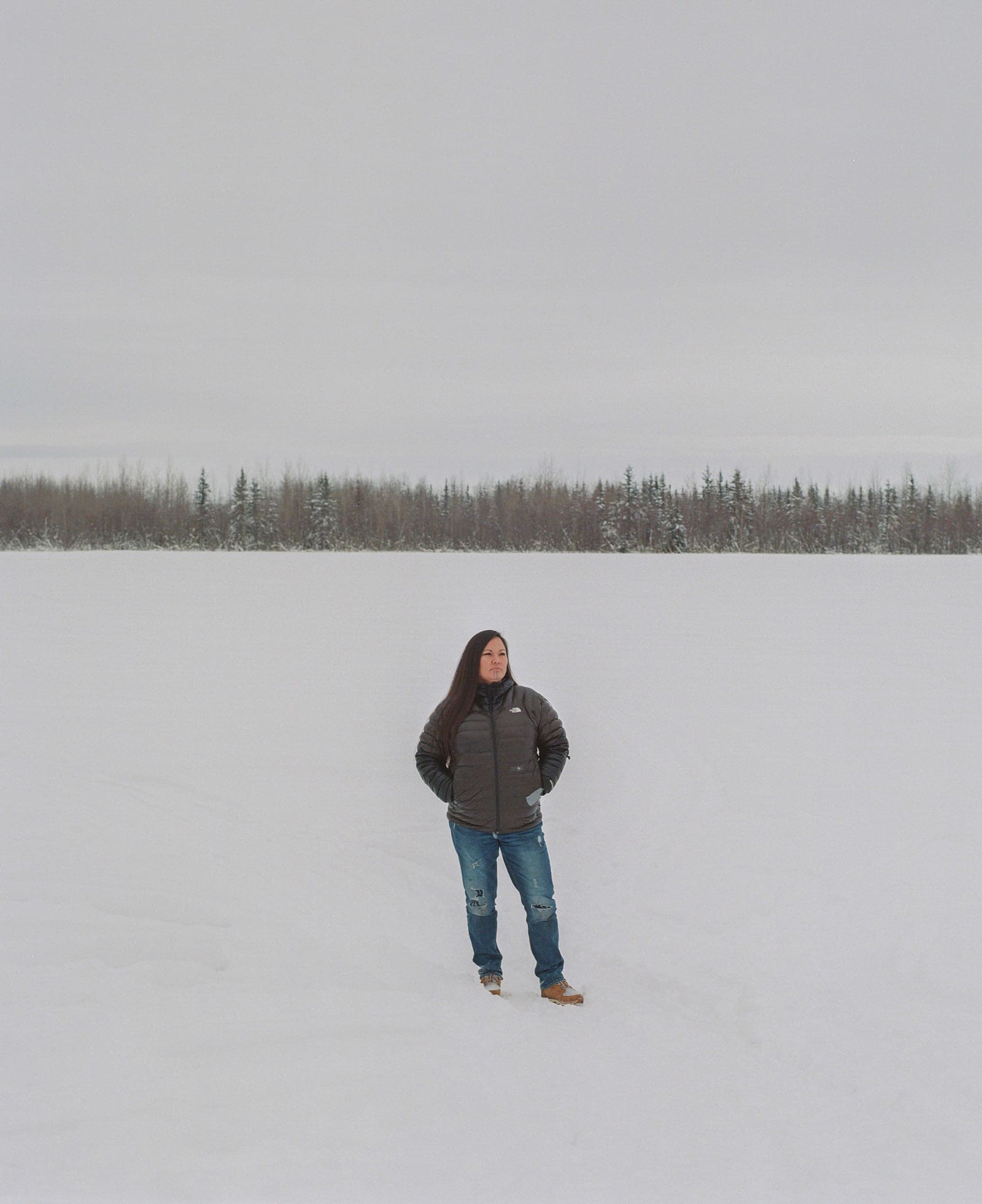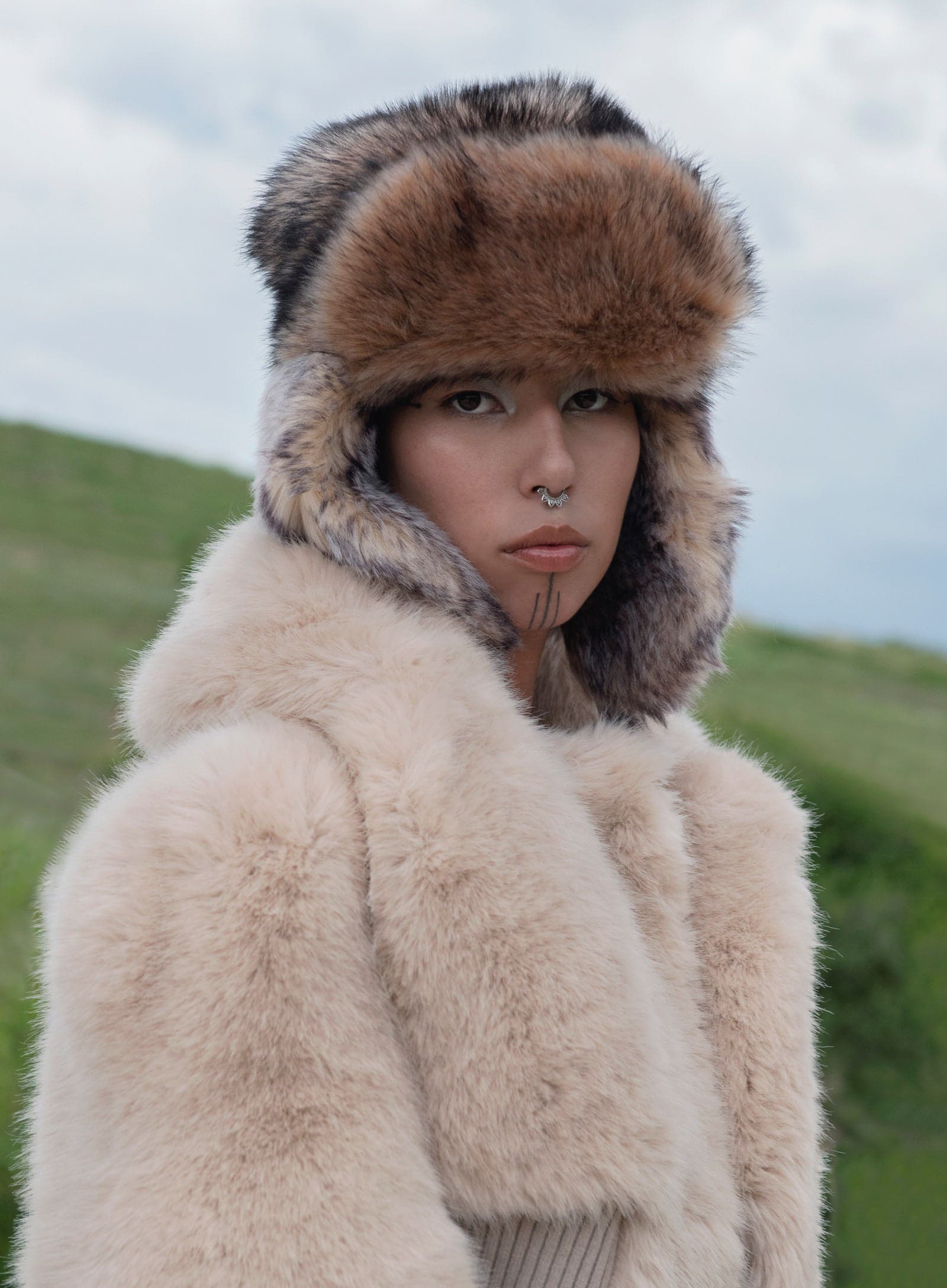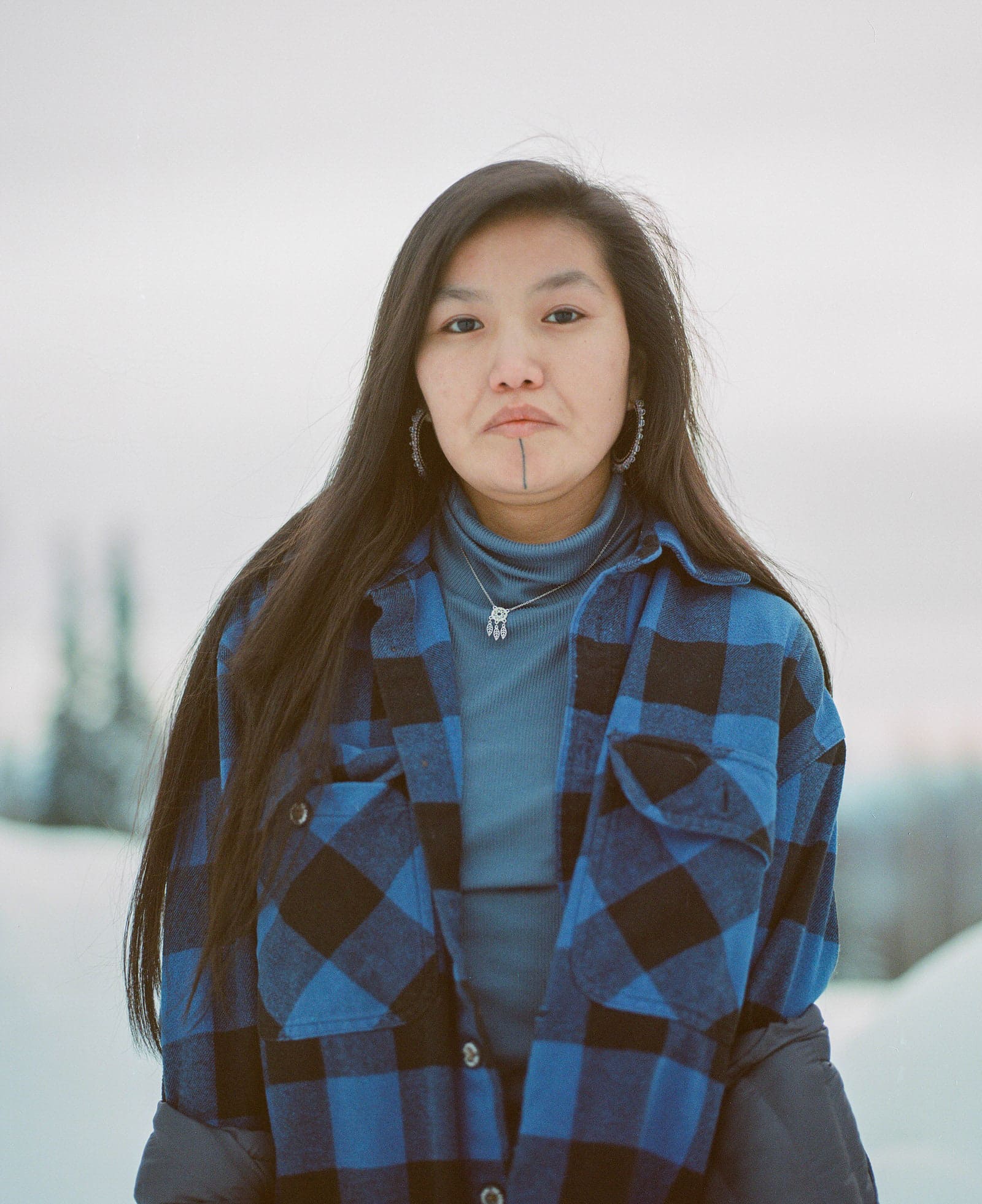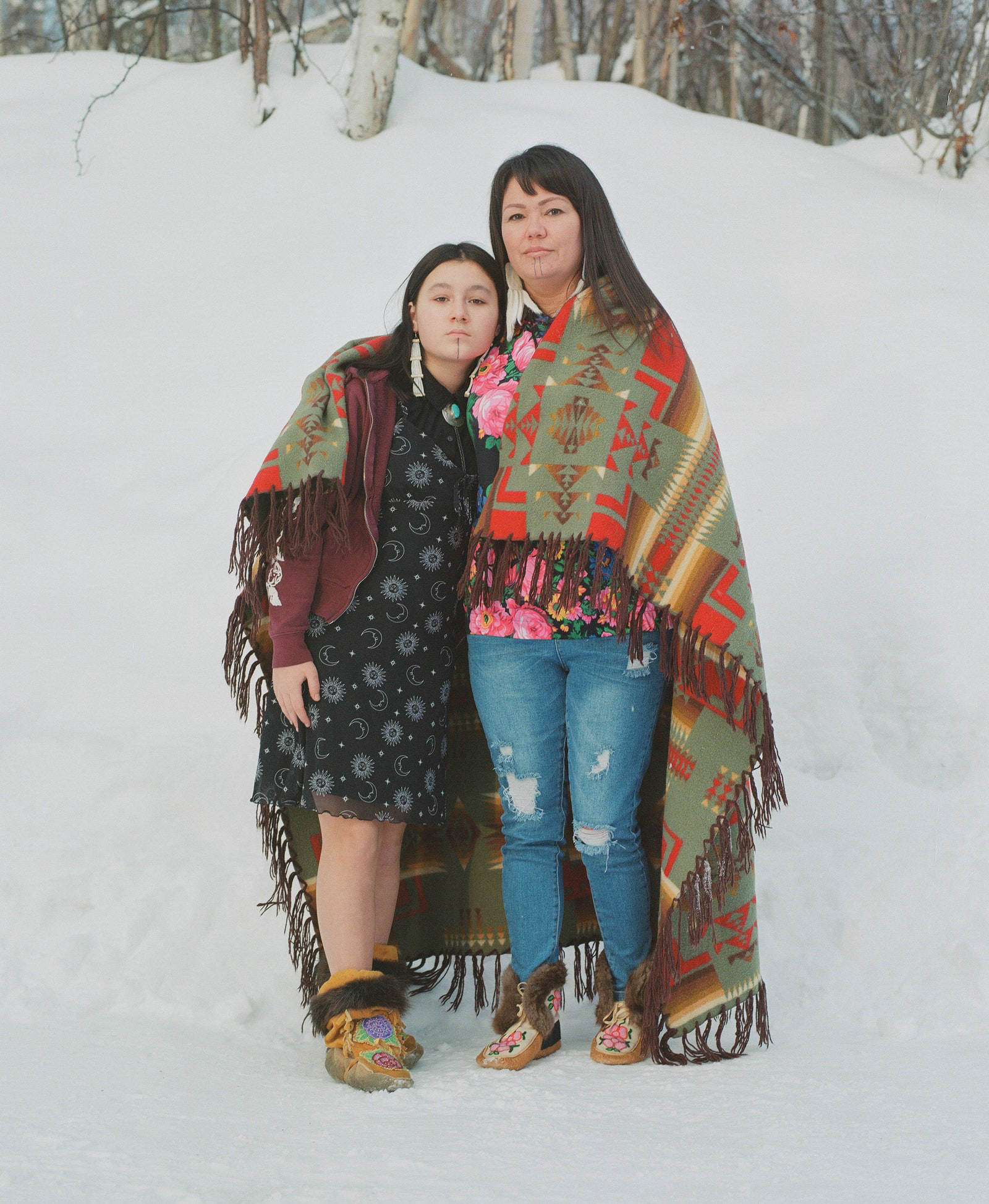Jody Potts-Joseph with her nieces, Jaelynn Pitka (left) and Lorena Village-Center-Simon in Fairbanks, AK.Photographed by Ash Adams
“They’re a symbol of strength, and a reminder of how hard our ancestors fought for us to be here.”
When she was 14 years old, Quannah Chasinghorse decided she wanted a traditional Indigenous face tattoo. The Hän Gwich’in and Oglala Lakota model—who has since, at age 19, made an impression on the fashion world after starring in Gucci campaigns and landing a Vogue Mexico cover—had grown up in Fairbanks, Alaska, seeing images of her ancestors wearing the three distinct chin lines called Yidįįłtoo. She asked her mother, Jody Potts-Joseph, if she would do the markings for her, using the traditional stick-and-poke technique to apply the ink. Though Potts-Joseph had never tattooed anyone before, she agreed. After sterilizing one of the skin-sewing needles that she normally used for hide projects, attaching it to a pen, and dipping it into a pot of gray ink, she got to work. “It was a powerful healing moment for my daughter,” says Potts-Joseph. “As I finished the tattoo, I felt that every poke provided Quannah with an immense amount of strength and power.”
A few months after doing Chasinghorse’s first tattoo, Potts-Joseph was inspired to reclaim the Yidįįłtoo for herself. She enlisted her oldest son, Izzy, who was 16 at the time, to do her own chin tattoos. As a single mom raising three children, Potts-Joseph says she and her daughter receiving their tattoos together brought the whole family closer; in a way, it allowed for a sense of healing after they had endured financial and personal hardships. “These tattoos really helped us find our strengths during a time that our family really needed it,” Potts-Joseph says. The markings were not only a proud symbol of Indigeneity, but they became a symbol of resiliency. In Alaska, an increasing number of Native women are carrying this idea forward, reclaiming the Yidįįłtoo and giving it a special new meaning.
Many Indigenous tribes around the world have distinctive traditional facial tattoos—the Māori have Tā Moko, the Inuit have Kakiniit—but Gwich’in tattoos often appear as three distinctive lines on the chin, as well as lines on the cheeks or corners of the eye. “The lines represent a rite of passage,” says Potts-Joseph. “Traditionally, a girl gets her first tattoo when they become a woman. During a girl’s first cycle, she would learn about the responsibilities of being a woman, and that’s when she would get her first traditional markings.” Lars Krutak—a tattoo anthropologist, research associate at the Museum of International Folk Art, and author of Ancient Ink: The Archaeology of Tattooing—says the Yidįįłtoo, a tradition which is at least 10,000 years old, was also used as a method of emotional healing, to display warrior status, and as a tribal identifier, too. “The width and spacing of a woman’s chin tattoos differentiated what group they came from,” he says. “There were nine Gwich’in groups in interior Alaska.”

For many, a Yidįįłtoo is an opportunity to reclaim a cultural tradition that was once almost lost. During colonization and amid the establishment of harmful boarding schools in the 19th and 20th centuries Indigenous people were once banned from practicing their cultural traditions, tattooing being one of them. “In Alaska, there’s a cultural revolution going on, where we’re reclaiming our identity and our culture,” says Potts-Joseph. “We’re being proud of who we are, and not being ashamed, because shame was really used on our people to control and assimilate us.” It’s part of a larger trend outside of Alaska too, where many different Indigenous tribes are reviving their tattoo practices. “Now more than ever, increasing numbers of Indigenous women and men are reclaiming their ancestral tattoos, from the Paiwan people of Taiwan, to the Kayabi of the Amazon,” says Krutak. “Taking ink beneath the skin helps erase the historical damage of betrayal and pain inflicted by others, because it is a form of permanent medicine.” Today, prominent figures proudly sport their traditional markings, like the TikTok star Shina Nova and the Māori broadcaster Oriini Kaipara.

The growing popularity of Yidįįłtoo in Alaska, specifically, is due to its large Gwich’in community as well as an abundance of tattoo practitioners who are drawing Indigenous women clients from all over North America. (Along with Potts-Joseph, some of Alaska’s most sought-out tattoo practitioners include Holly Nordlum, Sarah Ayaqi Whalen-Lunn, and Marjorie Tahbone.) Potts-Joseph is currently based in Stevens Village, a community of fewer than 100 people on the north bank of Alaska’s Yukon River. Since she started doing Yidįįłtoo about five years ago, she’s connected with clients through word-of-mouth and her Instagram page. While she charges non-Native folks for her stick-and-poke body tattoos, she never charges Indigenous women for their traditional Yidįįłtoo face markings, which she says are a more sacred process for her. “I just do trade for Native women; I ask them to trade the value of what it means to them,” says Potts-Joseph. “Some women have given me beadwork, medicine, or a box of caribou meat. I never want money to be a barrier to getting this powerful medicine that helps with healing.”

Potts-Joseph uses the traditional stick-and-poke technique for all of her tattoos, whether on the face or body. “Traditionally, we had needles made of bird bone,” says Potts-Joseph. These days, she uses standard tattoo needles. To lay the ink poke-by-poke, she secures a needle with adhesive tape onto a carved birch stick, for better grip. One line on a chin tattoo can take Potts-Joseph less than 30 minutes to do, but for a bigger design on the arm (which she’ll outline with transfer paper), it can take up to 8 or 9 hours. Potts-Joseph’s niece Jaelynn Pitka, a 21-year-old Athabascan and Hän Gwich’in teacher’s assistant, lives in Utqiagvik, one of the northernmost cities in the world. In July of 2021, she visited Potts-Joseph for the summer and received a chin Yidįįłtoo. This February, she flew back to get eye dots. She says the end result was more beautiful than she could have ever imagined—not to mention embedded with purpose. “For each woman, their traditional markings hold different meanings; mine represents resilience, bringing back our ways of life, and finding beauty in our culture,” says Pitka. “For me, they’re a symbol of strength, and a reminder of how hard our ancestors fought for us to be here.”
For many of the women Potts-Joseph tattoos, the experience of getting the Yidįįłtoo is just as meaningful as the end result. Lonnie Buresch, who is Denyeet Hutaana and Hän Gwich’in and based in Stevens Village, received her traditional face markings with her 12-year-old daughter, Roxy, last May. “The ceremony itself was the best experience,” says Buresch. “When you go into ceremony, time stops. It’s hard to describe, but it’s the same way when we sing our village’s songs—there’s a sense of connection and peace.” Potts-Joseph begins each Yidįįłtoo by smudging and praying for the woman she’s about to tattoo. “We have long conversations about what this means to them, and why they’re doing it,” says Potts-Joseph. “Then, I’m praying for their lives as I’m tattooing. That’s a good opportunity for them to get through the somewhat-painful experience of it—to pray and set their intentions for their life.” That’s precisely what Buresch did: “I prayed for [my daughter], Roxy, and for our future generations. We focused our energy on good thoughts—there was a lot of love in the room.”
As the art of Yidįįłtoo continues to gain prominence in Alaska and beyond, the Indigenous community is also working to defend what is theirs. The co-opting of Indigenous designs has long been an issue in the tattoo world, and as these traditional design motifs grow in popularity, instances of appropriation have increased. (Angelina Jolie, for example, recently wore facial jewelry that mimicked the lines of a Gwich’in face tattoo; the Indigenous community noticed). For a tattoo practitioner like Potts-Joseph, this is especially harmful to see considering that the Indigenous community was once oppressed and shamed for wearing them. “I really feel strongly about other people that are non-Indigenous wearing these markings, because it doesn’t belong to them,” says Potts-Joseph. “We’ve had so much taken from us over the years.”
She remains inspired, however, by seeing Indigenous women overcome this intergenerational trauma, one tattoo at a time. “Every time I see someone [with a Yidįįłtoo], we always talk and uplift each other,” says Potts-Joseph. “I’ve had elders come up and just give me a hug and say, ‘I haven’t seen a woman wearing a traditional tattoo since my grandma died.’ This is our way to regain something that was meant to be erased.”






